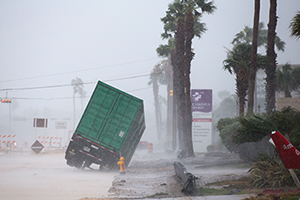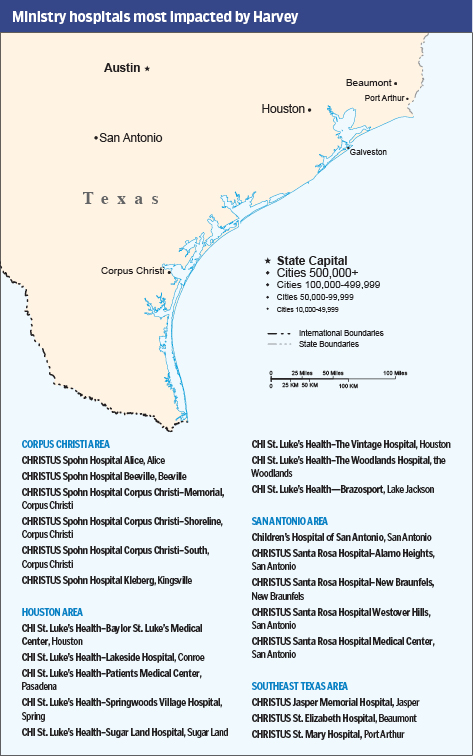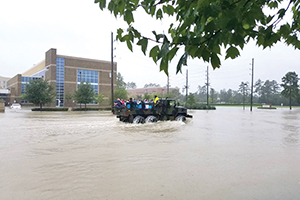By JULIE MINDA
Florida and other southeastern U.S. states anxiously prepared for a potential hit from Hurricane Irma, the powerful storm that devastated islands throughout the Caribbean and was projected to hit Florida around Sept. 10. Catholic health systems and facilities were among the many in that state stocking up on supplies, readying their disaster response plans, ensuring staff members' preparedness, keeping in touch with emergency response agencies and securing buildings and equipment against potential damage.

Photo by Courtney Sacco/Corpus Christi Caller-Times
"Hurricane Irma is now threatening Florida. … Bon Secours' operations in the St. Petersburg area are prepared to respond. We have already enacted our preparedness plan," Marriottsville, Md.-based Bon Secours Health System said in a statement, echoing similar assurances made by Florida ministries of Ascension and Trinity Health.
The preparations for Irma came just weeks after Hurricane Harvey brought devastation to the southeastern coast of Texas beginning Aug. 25. That storm brought the heaviest tropical downpour in U.S. history, spurring severe flooding throughout coastal communities. As Catholic Health World went to press, governmental and news sources were reporting that at least 65 people in the region had died, more than 33,000 had sought refuge in Texas shelters and more than 185,000 homes had been destroyed or damaged.
Catholic health systems and facilities located in and around the flood zones worked to ensure the safety and care of patients, staff and — in some cases — community members. Ernie Sadau, president and chief executive of Irving, Texas-based CHRISTUS Health, and Michael Covert, chief executive of Catholic Health Initiatives' Houston-based Texas division, said because of diligent preparations before Harvey hit, their facilities were able to respond effectively to swiftly changing circumstances during and after the storm.

About a dozen of CHRISTUS' 41 hospitals are located along the Texas Gulf coast, where the hurricane and follow-on tropical depression unleashed torrential rains measuring more than 50 inches in some locales.
Flood weary
Southeast Texas has weathered multiple hurricanes and floods in recent memory; lessons from past storms enabled CHRISTUS and CHI St. Luke's Health to gear up quickly and effectively for Harvey, said Sadau and Covert. Both systems set up command centers in their system offices days before the storm made landfall as a Category 4 hurricane. Their hospitals in the storm's projected path also set up on-site command centers. These teams coordinated internal and external communications, stayed in touch with emergency responders, mobilized equipment and supplies, monitored patients' health status and needs, arranged staffing and ensured vital services operated without interruption.
Both systems were able to maintain appropriate staff-to-patient ratios throughout the storm, thanks to emergency staffing plans. Each facility in the path of the storm brought in an initial group of staff to prepare for and hunker down during the hurricane. These staff members came ready for a multiple night stay. The scheduled relief teams came several days later.
Waterlogged
Harvey made landfall on the evening of Aug. 25 near Rockport, Texas. The storm stalled over the Texas coast, inundating Houston with nearly 52 inches of rain over about five days, according to The Associated Press.
CHI St. Luke's Health has eight hospitals in the greater Houston area. CHI Texas' Covert said six of CHI St. Luke's hospitals remained operational throughout the storm and flooding, with only minor power and phone issues that had no impact on the delivery of patient care.
Two CHI Texas sites closed: CHI St. Luke's Health – the Vintage Hospital in Houston and CHI St. Luke's Health – Sugar Land Hospital in Sugar Land, both within the greater metropolitan Houston area. Vintage evacuated its 29 inpatients Aug. 28 due to damage to the facility and concerns about floodwaters threatening to encroach upon its power plant. Sugar Land evacuated its 26 inpatients Aug. 29 due to concerns with flooding from the nearby Brazos River. Patients were evacuated to other CHI campuses, including CHI St. Joseph Health in Bryan, Texas. Another area site, CHI St. Luke's Health — Patients Medical Center in Pasadena, Texas, remained open but stopped accepting new patients after floodwaters rose several days after the storm. Multiple CHI St. Luke's clinics and other outpatient sites also closed due to the hurricane and floods. All CHI St. Luke's facilities reopened by Sept. 5.
CHI St. Luke's facilities sustained no significant damage. Covert noted that most were built on higher ground than many Houston structures, and so the hospitals became "islands" at the height of the flood. The facilities that stayed open remained accessible after the hurricane's retreat and saw emergency department volumes increase after the storm passed.
Covert said that supplies of essential materials, including food, water, blood and oxygen, held steady at the CHI St. Luke's sites during the storm and in its aftermath, but supply lines were threatened at times because of impassible roads throughout Houston. He said hospital supply chain staff and their vendors got creative, relying on boats in some cases to get supplies to the hospitals. No CHI St. Luke's site ran out of any essential supplies, Covert said.

People movers
Located just 30 miles southeast of the town where Harvey made initial U.S. landfall, Corpus Christi got about 10 inches of rain during the storm, and the area saw some flooding and damage from high winds.
The CHRISTUS Spohn Health System includes six hospitals in the Corpus Christi area, three of them in Corpus Christi proper. The day before Harvey hit Texas, CHRISTUS had closed its CHRISTUS Spohn Hospital Corpus Christi–Memorial campus because of flooding and power outage risk (the facility sustained only minor damage in the hurricane). The facility transferred its 11 inpatients about a mile away to sister hospital CHRISTUS Spohn Hospital Corpus Christi–Shoreline.
Many physician practices and other outpatient sites for the six-hospital Spohn system also preemptively closed and many of the hospitals cancelled elective procedures. CHRISTUS Spohn Hospital Corpus Christi–South transferred 13 babies by ground transportation to the neonatal intensive care unit at CHRISTUS' Children's Hospital of San Antonio.
Five Spohn hospitals — all of them in the Corpus Christi area — remained operational during Harvey. Sadau said they were the only hospitals in Corpus Christi that stayed open throughout the storm. All patients at the five hospitals remained safe throughout the storm and in its aftermath; the hospitals sustained no significant damage; and the floodwaters did not enter any of the buildings, Sadau said. Some CHRISTUS outpatient sites in the Corpus Christi area sustained minor damage.
By Sept. 7, when Catholic Health World went to press, the five-hospital CHRISTUS Santa Rosa Health System in San Antonio had received more than 90 patients, transferred from evacuating hospitals, primarily in the Houston area. Critical care nurses and other clinicians from CHRISTUS' Texarkana, Texas, and southern Louisiana region had traveled to San Antonio to augment the hospitals' taxed clinical teams.
Fresh challenges
As Harvey traveled east up the Gulf Coast of Texas, it dumped about 30 inches of rain on Beaumont and Port Arthur, east of Houston, causing significant flooding. Prior to the storm, CHRISTUS St. Elizabeth Hospital in Beaumont had transferred 37 adult inpatients and 11 neonatal intensive care unit patients by air to other CHRISTUS facilities. Sadau said CHRISTUS St. Elizabeth and Port Arthur's CHRISTUS St. Mary Hospital successfully sheltered associates and patients, and remained operational. CHRISTUS St. Mary and an outpatient site had minor flooding.
Despite Beaumont losing water supply during flooding, CHRISTUS St. Elizabeth was able to draw on other water sources and remain operational, returning to normal operations by Sept. 5. CHRISTUS reported that late the week of Aug. 28 it received an influx of people seeking care for storm-related injuries. As of Sept. 5, four CHRISTUS emergency centers in southeast Texas — including the one at CHRISTUS St. Elizabeth — had treated 1,400 patients in six days.
In the last days of August and first days of September, floodwaters were receding in Houston, and the area's CHRISTUS and CHI sites were returning to normal operations. Many of their outpatient sites had reopened, but the falling water levels were introducing new challenges, according to Sadau and Covert. Both men were expecting significant numbers of patients to seek medical care at CHRISTUS and CHI facilities' emergency departments as roads became more passable.
